Type of Equipment, Plants & More

Top 5 Best Plants for Koi Pond
Creating a balanced environment in your koi pond isn’t just about giving your fish a good home; it’s also about picking the right water plants. These plants make your pond look nice and help keep the water clean. They also give your fish places to hide and shade. In this guide, we will give you the list of the top 5 best plants for Koi Ponds. Whether you’re a pond pro or new to this hobby, knowing about these plants will help you make a happy home for your Koi fish.

1. Water Hyacinth (Eichhornia crassipes)
Water hyacinths are plants that float freely on the surface of water. They can grow in shallow or deep water and don’t need much care. They can grow in many different places, from the coldest parts of the U.S. to warmer areas near the equator. They have pretty purple and blue flowers that attract important pollinators like hummingbirds and bees. Koi fish enjoy eating these plants, which can be good because water hyacinths can spread quickly. But if they grow too much, they might crowd out other plants. Since koi eat them, you’ll need to clean your filter regularly to avoid clogging.
Benefits:
- Provides shade, reducing algae growth.
- Like other aquatic plants, water hyacinth contributes to oxygenation of the water.
- Water hyacinth provides habitat and shelter for various aquatic organisms, including small fish, insects, and beneficial microorganisms.

2. Water Smartweed (Persicaria amphibia)
Water hyacinths are plants that float freely on the surface of water. They can grow in shallow or deep water and don’t need much care. They can grow in many different places, from the coldest parts of the U.S. to warmer areas near the equator. They have pretty purple and blue flowers that attract important pollinators like hummingbirds and bees. Koi fish enjoy eating these plants, which can be good because water hyacinths can spread quickly. But if they grow too much, they might crowd out other plants. Since koi eat them, you’ll need to clean your filter regularly to avoid clogging.
Benefits:
- Smartweed adds oxygen to the water.
- It cleans the water.
- Smartweed provides food for bugs and birds.

3. Water Lotus (Nelumbo lutea)
Beautiful and popular floating plants in ponds are lotus plants. They require particular circumstances to flourish, yet they are simple to care for. They prefer water that is at least eighteen inches deep and between 75 and 87°F. They require at least five hours of sunlight per day and like low humidity levels. Because they may produce large leaves that can reach up to two feet in width, lotus plants also require a lot of area! They work best in larger koi ponds, therefore. There are smaller varieties of lotus plants for smaller ponds. Lotus plants offer pleasant shade in hot times, and koi fish aren’t particularly interested in eating them. They also aid in luring in nearby pollinators.
Benefits:
- Water lotus helps to oxygenate the water.
- It can reduce algae growth by shading the water.
- Water lotus provides habitat for small aquatic creatures.

4. Hornwort (Ceratophyllum demersum)
Lilies are a popular choice for koi ponds. They’re like smaller versions of lotus plants and can grow well in cooler water with less sunlight. They float on the water’s surface and have lovely-smelling flowers. They can grow in shallow water, as little as 6 inches deep, or in deeper areas too. Koi fish like to munch on the leaves and roots of lilies. They also use the lily pads to hide under and lay their eggs on the bottom of the leaves.
Benefits:
- Hornwort helps to oxygenate the water in your pond.
- It absorbs excess nutrients, helping to reduce algae growth.
- Hornwort provides hiding places for small fish and aquatic creatures.
- It can improve water clarity by filtering out impurities.
- Hornwort is low-maintenance and easy to grow, making it ideal for beginner pond enthusiasts.

5.Scouring Rush (Equisetum)
Scouring rushes are ancient plants that have been around for millions of years, and they’re the only ones left of their kind. They’re tough and can grow along the edges of water or even in shallow water. Another plant, horsetail, is very similar to scouring rushes and also does well in similar conditions. These plants are great at cleaning water, and they grow in tall sections that hold water. You can remove or trim them without killing the whole plant. They usually don’t take over or crowd out other plants, but if they do, they’re not too hard to get rid of. They have deep roots that spread out, similar to cattails, so if you don’t want them to come back, you’ll have to pull up all of the roots gently. Koi fish might use horsetails for shade, but they usually don’t eat them.
Benefits:
- Scouring rush helps to stabilize soil around your pond.
- It absorbs excess nutrients, improving water quality.
- Scouring rush provides habitat for beneficial pond insects.
- It can prevent erosion along pond edges.
- Scouring rush adds a unique aesthetic with its tall, bamboo-like stems
To sum up, adding the right plants to your koi pond is super important for making sure everything stays healthy and happy. These top 5 plants do a lot of good things, like giving shade, making oxygen, and keeping the water clean. They also bring in cool animals to your pond. Whether you’re a pro at ponds or just getting started, these plants will make your pond look amazing and keep it in balance.
Image & Description Source: https://pondinformer.com/best-plants-for-koi-ponds/
SPECIAL INFORMATION
Pond (Expert Tips on Maintaining your Koi Pond)
Taking care of a koi pond needs a lot of time and work. To make sure your fish stay happy and healthy, you have to do a bunch of things, like keeping the water clean and feeding them right. If you own a Koi pond, it’s really important to learn how to take care of it properly. On this page, we will share you five good tips for keeping your koi pond healthy. They talk about stuff like making sure the water is good, using filters, and adding plants. If you follow these tips, your koi pond will stay in good shape, and you can enjoy having a beautiful and peaceful spot in your yard.
1. Improve Circulation
Having a good pond filter is really important, but it can only work well if the water it’s filtering is clean. When fish eat, they make a lot of waste. This waste sinks to the bottom of the pond and can make too much algae grow. Then, the filter has to deal with even more waste, which can be too much for it. To stop this from happening, it’s important to make sure the water moves around well in the pond. This helps move the waste back to the filter so it can clean it up. The best shape for a pond to do this is a round one because it lets the water move around easily. But most people like rectangular ponds because they look nicer, even though they can have problems with water flow and waste buildup. To fix these problems, it’s a good idea to round off the sharp corners and smooth out any curves in the pond. This helps the water move better.
2. Add plants to your pond
Adding plants to your koi pond can make it look nicer and help keep the water clean. It’s a good idea to put plants like marginal pond plants around the edge of the pond, about 50 cm apart. You can use a shallow shelf for this, but make sure it’s not too deep, so the koi don’t bother the plants. If you don’t have a shelf, you can use floating baskets or mats that let plants grow over the water. Having plants in your pond can also stop it from turning green in a bad way. So, adding plants to your koi pond can make it look better and help keep your fish and the pond healthy.
3. Regularly clean your Pond Filter
Keeping your filter clean is really important to make sure it keeps working well. In the summer when it’s hot, you should clean it once a week. In the spring and fall, every two weeks is good. In the winter, once a month is enough. It’s better to clean it regularly in smaller bits because it saves time later on.
When you clean your filter, don’t use tap water on the filter parts. Instead, use water from the pond that you’ve taken out. Some filters have special features to make cleaning easier, and some even clean themselves automatically!
4. Properly Treat the Water
If you fill your koi pond with tap water, it has chlorine in it to keep it clean. But chlorine can hurt fish and mess up the good bacteria in the filter. It’s best to take the chlorine out of the water before putting fish in. Some people don’t like adding chemicals to their ponds, so they use water purifiers instead. You can also use rainwater, but you have to make sure it’s not been sitting around for too long. Stagnant water can have low oxygen and a bad pH level. Testing the water before putting it in the pond can help make sure it’s safe for the fish. You might not have to test the water every time, but it’s still a good idea to be careful.
If you need to change the water quickly and don’t have a conditioner or filter, there’s one more thing you can try. Put the hose in the pond with a brick to hold it down, and set the nozzle to make a fine mist. This helps get rid of the chlorine, even though it’s not the best way. It’s better than doing nothing at all.
5. Oxygenate your Pond
In cold weather, it’s a good idea to reduce how much the pond water touches the air. The most common way to add oxygen to the pond is by use of a waterfall. Anything that disrupts the pond surface will help add oxygen. The only place where oxygen can effectively be transferred into the pond water is at the pond surface where the atmospheric pressure on the water and the oxygen is equal. This helps because fish breathe slower when it’s cold, so they don’t need as much oxygen. But in warm weather, you want the water and air to mix a lot to help the fish breathe better. So, turn everything on full to increase how much the water and air mix. Putting in an air pump during the summer can also help save fish by putting oxygen into the water and making more room for air to mix with the water.
You can also add air to filters to help clean the water better.
Some filters have an air pump in case the main one stops working.
There are also solar air pumps that can help if the power goes out.
In the winter, you don’t want the pond to freeze completely because
it stops air from getting into the water, which can hurt the fish.
Use a filter with an air pump to clean it and keep the
pond healthy most of the time.
These expert tips provide the knowledge and guidance needed to effectively care for your Koi pond, promoting its longevity and the well-being of your beloved Koi fish. With proper maintenance and attention to detail, you can create a tranquil and picturesque oasis for both you and your Koi to enjoy for years to come.
Description Source:https://healthyponds.com/koi-pond-maintenance-5-expert-tips/
Top 5 Essential Tools/Equipments for your Pond
1.The Pond Skimmer
A heavy-duty pond skimmer is definitely a crucial pond cleaning tool. Pond Skimmers can be used to keep the pond free of leaves and other debris and they are great to have in a pond because they can prevent you from having to use a net to dip these things out of the water. With this in mind, it is still a good idea to have a net nearby in case larger debris gets into your pond. If you’ve got a small koi pond, a light skimmer might do the trick, but for bigger ponds, go for a heavy-duty one. They’re sometimes just called pond nets, and it’s smart to have two types.
Image Source : https://www.grassrootspondandgarden.com/pond-skimmer-costs/
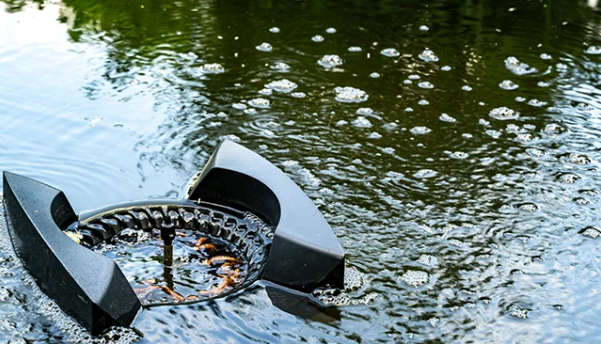
2.The Pond Rake
he rake is a great tool for cleaning your pond, especially after cutting weeds with a weed cutter. It can also remove muck and floating stuff from your pond. It’s best to rake around the edges, but some rakes come with a rope so you can toss them into the middle of the pond to get stuff from there too. Usually, junk gathers around the edge first because the water is shallower and warmer. But junk can still end up in the middle, so it’s important to remove it quickly to keep the water clean. You can also use a pond rake to tidy up the sand around your pond’s edge and make it look nice.
Image Source: https://www.amazon.com/Zilla-Extra-Large-Heavy-Aquatic/dp/B07CD7HX26?th=1
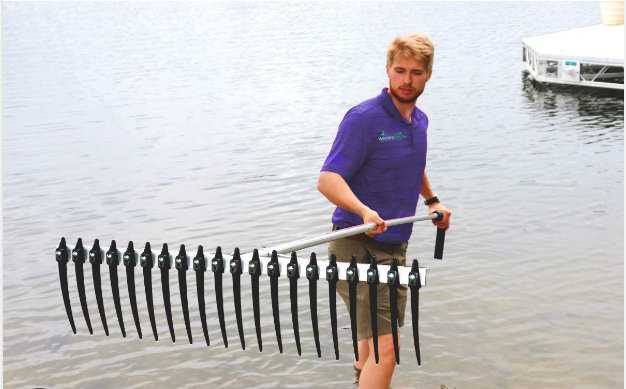
3.Aerators
Aerators are great for making pond water healthier. They stop the water from getting still, which can lead to yucky stuff like floating junk, bad smells, and mosquitoes. Some aerators even keep oxygen levels steady in winter when ponds freeze on top in cold places. There are two main types of aerators: surface aerators and bottom diffusion aerators. Surface ones, like fountains, are good for shallow ponds. But if your pond is deeper, you should go for a bottom diffusion aerator. However, you can use a bottom one for any pond, and they’re usually cheaper to run. There are even aerators powered by wind or sunlight. Both types of aerators move the water around in your pond and keep the oxygen levels up. They also stop floating junk and weeds from building up. Using aerators can save you a lot of work in keeping your pond clean and healthy.
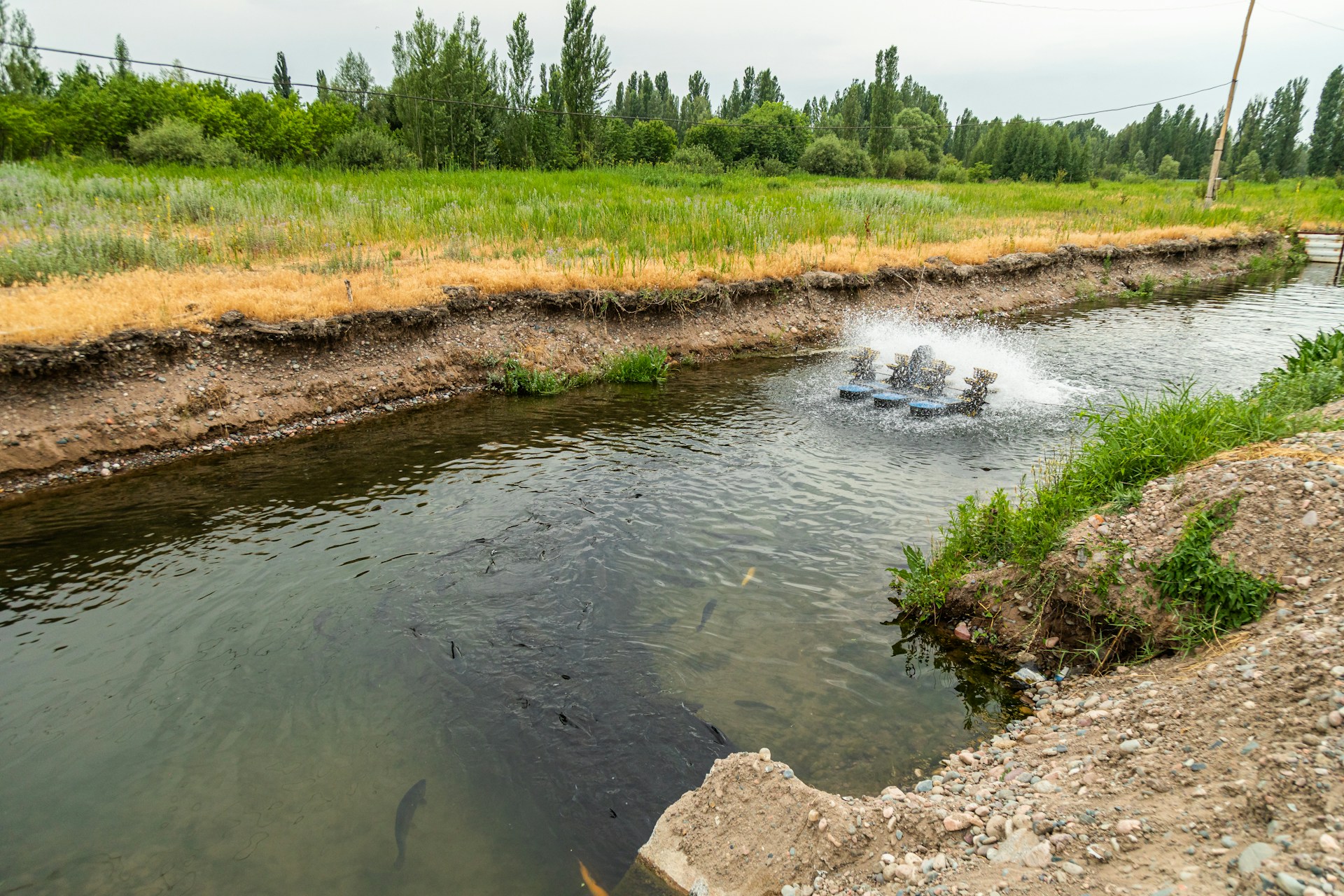
4.Pond Weed Cutters
There are various kinds of tools for cutting weeds in water. Some look like rakes, and others have two blades that spread out. We suggest not only removing the weeds but also treating the water. We have different treatments to stop or reduce different kinds of weeds and floating junk.
Image Source: https://www.thepondguy.com/product/jenlis-weedrazer-aquatic-weed-cutter/
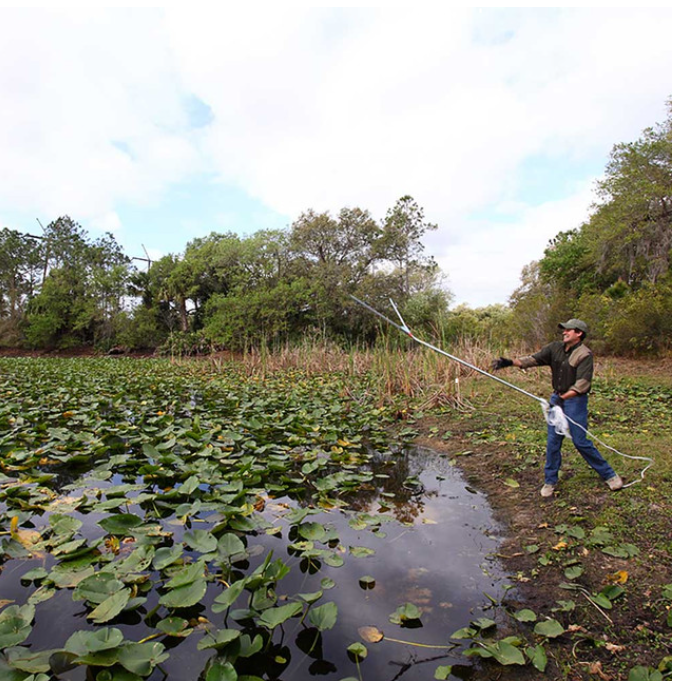
5.Pond Vacuums
For smaller ponds, a pond vacuum can be a very handy tool helping you remove muck, weeds and other debris. There are many different types of vacuums, so you will need to do some research to determine which type of vacuum is the best option for your size and type of pond. With large ponds and lakes, a vacuum probably isn’t going to be much of a help. If muck and sediment are building up at the bottom of your pond or lake, it might be worth the expense to hire a company to come out and dredge the lake.
Image Source: https://fishlab.com/best-pond-vacuum/
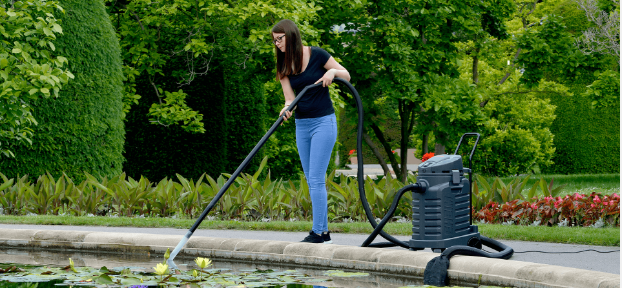
Having the right tools is crucial for maintaining a healthy and beautiful pond. With our selection of five essential tools, you’ll have everything you need to keep your pond clean, clear, and thriving. From filtration systems to pond skimmers and pumps. Invest in these essential tools too and enjoy a pond that’s teeming with life and natural beauty for years to come.
Description Source: https://blog.aquaticwarehouse.com/koi-pond-supplies/
& https://healthyponds.com/5-essential-pond-cleaning-tools/